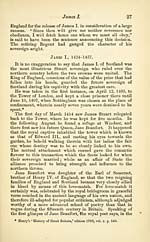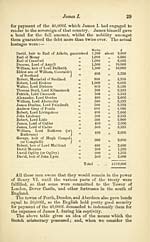Stuart dynasty
(48) Page 28
Download files
Complete book:
Individual page:
Thumbnail gallery: Grid view | List view

28 The Stuart Dynasty.
1 King's Quhair ' (as quoted in Chalmers's ' Poetical Kemains
of the Scottish Kings,' p. 40) : —
" And therewith cast I down mine eye again,
Where as I saw walking under the tower full secretly
* * * *
The fairest or the freshest young flower
That ever I saw methout before that hour."
It was in February of the year 1424 that James I. married
Jane Beaufort in the Church of St. Mary Overy, Southwark,
the alliance being celebrated by a feast given in the palace
of the bride's uncle, Cardinal Beaufort, a man of vast wealth
and ambition.*
In the year 1420 the captive King James accompanied
Henry V. into France as a counterpoise to the presence in
that kingdom of 7000 Scots under John Stuart, Earl of
Buchan, who afterwards, by his victory at Beauge on
March 22, 1421, demonstrated the possibility of stemming
the tide of English invasion.
Henry's aim was to interpose the King of Scotland's
authority to oblige the Scots to return home, and although
the Earl of Buchan repudiated an authority urged by his
sovereign when acting under compulsion, an excuse was
afforded for Henry V. treating all Scotchmen opposed to him
in France as rebels.f
This period of James's life spent across the Channel is
little commented on by the chroniclers, French or English,
and presents one of the by-paths of history open to the efforts
of modern explorers. He is known to have been at the
coronation of Catherine Queen of France, in 1420, while two
years later Eymer the chronicler speaks of the captive King
o' Scots as being in that country.! Nor was the return of
James I. to his own dominions effected without long negotia-
tions, resulting in a treaty which called for considerable
sacrifice on the part of the smaller kingdom.
It is difficult to realise how highly the Scotch people in
the fifteenth century valued their monarchical institutions.
Strong evidence of their loyal devotion remains, however,
recorded. For we know that the following individuals of
title and station were prepared to enter England as hostages
* Tytler's ' History of ScotlafKl,' edition 1841, vol. iii. p. 169.
f Rapin's ' History of England,' fourth edition, vol. iv. p. 281.
J Chalmers's ' Poetical Remains of the Scottish Kings,' edition 1824, p. 9.
1 King's Quhair ' (as quoted in Chalmers's ' Poetical Kemains
of the Scottish Kings,' p. 40) : —
" And therewith cast I down mine eye again,
Where as I saw walking under the tower full secretly
* * * *
The fairest or the freshest young flower
That ever I saw methout before that hour."
It was in February of the year 1424 that James I. married
Jane Beaufort in the Church of St. Mary Overy, Southwark,
the alliance being celebrated by a feast given in the palace
of the bride's uncle, Cardinal Beaufort, a man of vast wealth
and ambition.*
In the year 1420 the captive King James accompanied
Henry V. into France as a counterpoise to the presence in
that kingdom of 7000 Scots under John Stuart, Earl of
Buchan, who afterwards, by his victory at Beauge on
March 22, 1421, demonstrated the possibility of stemming
the tide of English invasion.
Henry's aim was to interpose the King of Scotland's
authority to oblige the Scots to return home, and although
the Earl of Buchan repudiated an authority urged by his
sovereign when acting under compulsion, an excuse was
afforded for Henry V. treating all Scotchmen opposed to him
in France as rebels.f
This period of James's life spent across the Channel is
little commented on by the chroniclers, French or English,
and presents one of the by-paths of history open to the efforts
of modern explorers. He is known to have been at the
coronation of Catherine Queen of France, in 1420, while two
years later Eymer the chronicler speaks of the captive King
o' Scots as being in that country.! Nor was the return of
James I. to his own dominions effected without long negotia-
tions, resulting in a treaty which called for considerable
sacrifice on the part of the smaller kingdom.
It is difficult to realise how highly the Scotch people in
the fifteenth century valued their monarchical institutions.
Strong evidence of their loyal devotion remains, however,
recorded. For we know that the following individuals of
title and station were prepared to enter England as hostages
* Tytler's ' History of ScotlafKl,' edition 1841, vol. iii. p. 169.
f Rapin's ' History of England,' fourth edition, vol. iv. p. 281.
J Chalmers's ' Poetical Remains of the Scottish Kings,' edition 1824, p. 9.
Set display mode to:
![]() Universal Viewer |
Universal Viewer | ![]() Mirador |
Large image | Transcription
Mirador |
Large image | Transcription
Images and transcriptions on this page, including medium image downloads, may be used under the Creative Commons Attribution 4.0 International Licence unless otherwise stated. ![]()
| Histories of Scottish families > Stuart dynasty > (48) Page 28 |
|---|
| Permanent URL | https://digital.nls.uk/94818342 |
|---|
| Description | A selection of almost 400 printed items relating to the history of Scottish families, mostly dating from the 19th and early 20th centuries. Includes memoirs, genealogies and clan histories, with a few produced by emigrant families. The earliest family history goes back to AD 916. |
|---|

